

CDT - Shelly Sanchez Terrell. ELLs - Shelly Sanchez Terrell. Teaching Young Children About Bias, Diversity, and Social Justice. When my daughter was three years old, I taught her the word "stereotype.
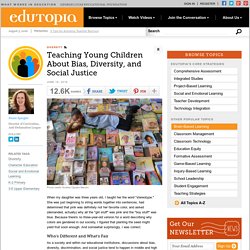
" She was just beginning to string words together into sentences, had determined that pink was definitely not her favorite color, and asked (demanded, actually) why all the "girl stuff" was pink and the "boy stuff" was blue. Because there's no three-year-old version for a word describing why colors are gendered in our society, I figured that planting the seed might yield fruit soon enough. Culturally Responsive Teaching. Teaching Refugees with Limited Formal Schooling. For students with refugee backgrounds academic success is connected with engaging in the school community.
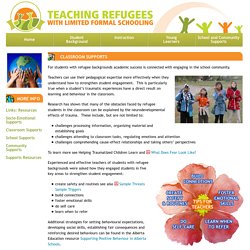
Teachers can use their pedagogical expertise more effectively when they understand how to strengthen student engagement. This is particularly true when a student’s traumatic experiences have a direct result on learning and behaviour in the classroom. Research has shown that many of the obstacles faced by refugee students in the classroom can be explained by the neurodevelopmental effects of trauma. Culturally Responsive Teaching. CulturallyResponsiveTeaching Matters. Teaching Tolerance - Diversity, Equity and Justice. We are all born, raised and enveloped in culture, and it is central to learning.
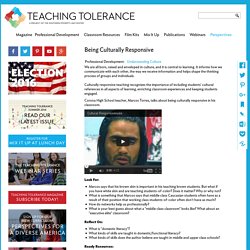
It informs how we communicate with each other, the way we receive information and helps shape the thinking process of groups and individuals. Teaching Tolerance - Diversity, Equity and Justice. Edutopia. Precious Children: Diversity in the Classroom. In our increasingly pluralistic society, it is important to raise children with a greater awareness of others around them, especially those who are different.
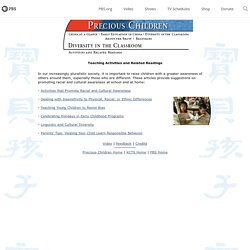
ePals. Mystery Hangout - Community. Honoring Our Families' Immigrant Narratives. As we navigate a political landscape that is too often hostile toward immigrants, it's a good time to remember that the vast majority of us are here as American immigrants.
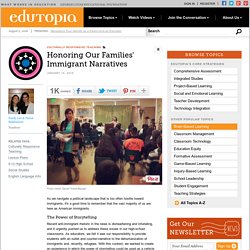
The Power of Storytelling Recent anti-immigrant rhetoric in the news is disheartening and infuriating, and it urgently pushed us to address these issues in our high-school classrooms. As educators, we felt it was our responsibility to provide students with an outlet and counter-narrative to the dehumanization of immigrants and, recently, refugees. With this context, we wanted to create an experience in which the power of storytelling could be used as a vehicle for empathy, community, and great writing. We are ninth-grade English and history teachers at a small California charter school that serves many first-generation students. More notably, the task privileged students whose families are recent immigrants or who had personally emigrated here themselves. Creating the Narrative 1. Resources: Asking Questions Skill Rubric. Being Mindful of Cultural Differences. Rusul Alrubail , Writer/Edutopia Community Facilitator/Chief Education Officer at The Writing Project Posted 01/13/2016 7:01PM | Last Commented 05/31/2016 5:02AM When teaching a diverse group of students, whether they are English language learners or English speakers but have a different cultural background, it’s important to be mindful of the cultural differences in students’ behaviour.
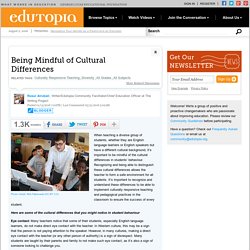
Recognizing and being able to distinguish these cultural differences allows the teacher to form a safe environment for all students. [3645] Bridging the Cultural Barrier with Immigrant Parents. Teaching Tolerance - Diversity, Equity and Justice. When I teach my adult English language learners, I often tell them my story of arriving to Canada and learning a new language at the age of 11.

They feel very inspired and motivated that one day they will be able to communicate easily and have a career in their new country upon graduation. My story is inspiring to them and allows us to connect over cultural changes, language barriers and challenges that come with being an immigrant. But, often times, I feel the need to remind them and myself that our immigration experiences are not homogenous. Understanding the depths of immigrant experiences, especially those of immigrant students, helps us educators to foster culturally responsive teaching in the classroom. International High School at Lafayette: Team Transitions Native Language Memoirs.
REX Lonely Finger Christmas. Resources for teaching English to refugees in the US. When refugees arrive in America, their orientation often includes some survival English language.

This instruction is often done by volunteers with little training and materials. Tips for teaching English to migrants and refugees in the UK. Rachel Thomas teaches a weekly ESOL (English for Speakers of Other Languages) class in Streatham, South London.

DUP373 Immigration Reform Final. 3 Tips to Make Any Lesson More Culturally Responsive (And it’s not what you think!) Last month, I reviewed Zaretta Hammond’s fantastic book, Culturally Responsive Teaching and the Brain.
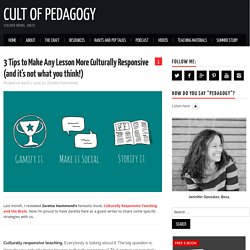
Now I’m proud to have Zaretta here as a guest writer to share some specific strategies with us. Culturally responsive teaching. Everybody is talking about it. The big question is: How do you actually make lessons culturally responsive? That comes up regularly when I am working with groups of teachers to improve outcomes for diverse students who are struggling. Educational Leadership:Strengthening Student Engagement:A Framework for Culturally Responsive Teaching. Teaching Knowledge Test Prep. Reading is a complex activity and we know that many of our learners are not accustomed to reading in their first language, let alone reading in the target language. When we create a collaborative communicative context for students to work on subskills in the target language, we begin to promote not only reading subskills, but we also promote collaboration, speaking skills, writing skills and listening skills.
It is difficult to work with any language skill without integratiang it. How To Choose The Best Multicultural Books. How do you know if a children's book you're about to share with your students accurately portrays the culture of its characters? Pathfinders. General Purpose Reading multicultural literature can help children gain a better understanding of people from other countries and ethnic backgrounds. These stories may describe how people live in different parts of the world, or they may portraying how children from different cultural backgrounds live together in the same country. They can be fiction, nonfiction, folk tales, fairy tales, legends, or poetry, but above all they must be accurate and portray characters in positive, non-stereotypical ways. The information presented here will help parents, teachers, and other interested adults find bibliographical lists of high quality multicultural materials for children of all ages.
Why should children read mulicultural literature? Reading literature about people from other cultures has been proven to have positive developmental affects on children of all backgrounds. Multicultural Literature. CCBC Booklists. Compiled by Megan Schliesman, Kathleen T. Horning and Merri V. Lindgren. CCBC Booklists. Compiled by Kathleen T. An Eleven-Year-Old’s Quest To Spotlight Black Girls In Literature. Marley Dias is like a lot of 11-year-olds: She loves getting lost in a book. But the books she was reading at school were starting to get on her nerves. Blue Planet Tales, cuentos interactivos para niños.